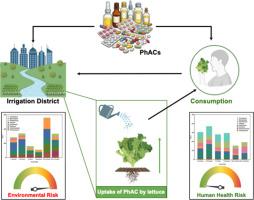Occurrence and risk assessment of pharmaceuticals in irrigation water and lettuce crops in Colombia
IF 7.7
Q2 ENGINEERING, ENVIRONMENTAL
引用次数: 0
Abstract
This study presents the first detailed investigation into the occurrence and risk of pharmaceutically active compounds in irrigation water and lettuce crops within the critical agricultural region of Sabana de Bogotá, Cundinamarca, Colombia. Systematically were analyzed eight pharmaceutically active compounds (PhACs)—including an antiepileptic drug, five antibiotics, one antihypertensive, and one anti-inflammatory—across six farms along the Bogotá River using liquid chromatography-tandem mass spectrometry.
The findings reveal a widespread presence of PhACs in irrigation water, with Farm C-Principal exhibiting the highest detection frequency (97 %) and M-La Victoria showing the highest total concentration (613 ng/L). Clarithromycin and ciprofloxacin were the most concentrated among consistently detected PhACs.
Principal Component Analysis was used to reduce the dataset's dimensionality and identify correlations among the variables. The study also estimated PhACs loading rates into lettuce crops using average water concentrations and CropWat software, with estimated inputs ranging from 5.2 to 26.3 g/ha per crop cycle. Crucially, several PhACs were detected in lettuce, with diclofenac (up to 70.9 ng/g) and trimethoprim (up to 61.6 ng/g) being the most frequently observed. While ecological risk assessment indicated a high risk from pharmaceuticals in irrigation water, particularly clarithromycin, trimethoprim, and diclofenac, the human health risk from consuming the irrigated lettuce appeared negligible. This research provides critical baseline data on PhACs contamination in the Sabana de Bogotá region, which is essential for informing future research and developing effective mitigation strategies.

哥伦比亚灌溉用水和生菜作物中药物的发生及风险评估
本研究首次详细调查了哥伦比亚Cundinamarca的Sabana de bogot关键农业区灌溉水和生菜作物中药物活性化合物的发生和风险。系统地分析了波哥大河沿岸六个农场的八种药物活性化合物(PhACs),包括一种抗癫痫药,五种抗生素,一种抗高血压药和一种抗炎药。研究结果显示,PhACs在灌溉水中广泛存在,农场C-Principal的检测频率最高(97%),M-La Victoria的总浓度最高(613 ng/L)。在一致检测的phac中,克拉霉素和环丙沙星的浓度最高。主成分分析用于降低数据集的维数并识别变量之间的相关性。该研究还利用平均水分浓度和CropWat软件估计了PhACs在生菜作物中的装载率,估计每个作物周期的投入量为5.2至26.3克/公顷。关键是,在生菜中检测到几种PhACs,其中双氯芬酸(高达70.9 ng/g)和甲氧苄啶(高达61.6 ng/g)是最常见的。虽然生态风险评估表明灌溉水中的药物风险很高,特别是克拉霉素、甲氧苄啶和双氯芬酸,但食用灌溉生菜对人类健康的风险似乎可以忽略不计。这项研究提供了关于萨巴纳德波哥大地区多氯联苯污染的关键基线数据,这对于为今后的研究提供信息和制定有效的缓解战略至关重要。
本文章由计算机程序翻译,如有差异,请以英文原文为准。
求助全文
约1分钟内获得全文
求助全文
来源期刊

Journal of hazardous materials advances
Environmental Engineering
CiteScore
4.80
自引率
0.00%
发文量
0
审稿时长
50 days
 求助内容:
求助内容: 应助结果提醒方式:
应助结果提醒方式:


